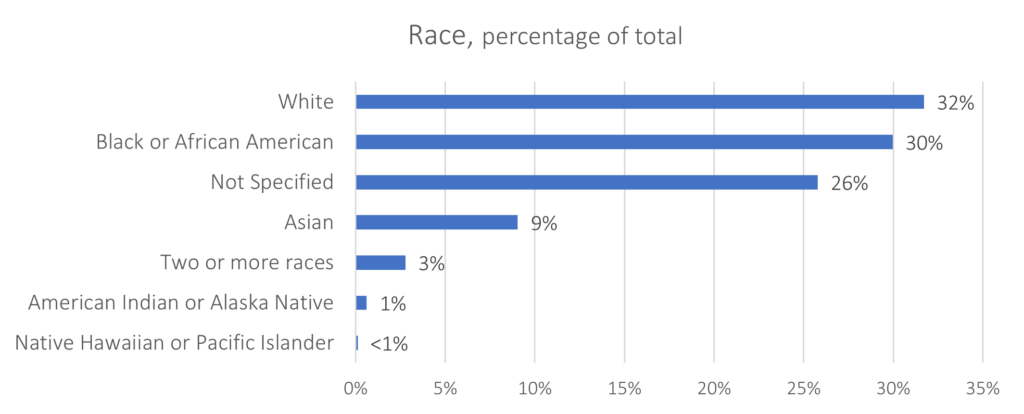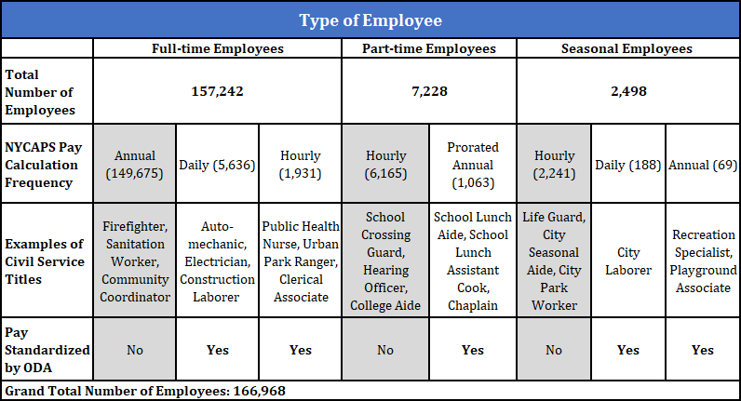This is the third annual publication of the Pay and Demographics Report on City of New York agency workforce pay and employment information in compliance with Local Law 18 of 2019. The Report is based on municipal workforce data as of December 31, 2021.
1. Background
Local Law 18 of 2019 (LL18) requires the Department of Citywide Administrative Services (DCAS) to collect data from agencies relevant to pay and employment of the City’s municipal workforce every year and to make this data available to the Mayor’s Office of Data Analytics (MODA). MODA is then responsible for three requirements:
- To issue a report on specific attributes of the data, aggregated by pay band, and post the report on the MODA Open Source Analytics Library;
- To provide data as required by LL18 to the City Council for 90 days; and
- Starting with the second year of the reporting cycle (2021), to conduct an annual analysis of the data, in conjunction with DCAS, to identify potential disparities based on gender, race, or other protected classes in terms of pay, employment rates, and retention rates.
This is the third annual publication of the Pay and Demographics Report on City of New York agency workforce pay and employment information in compliance with the first requirement above for 2022. This Report documents how the data in the Agency Report Table were aggregated. This year’s Agency Report Table is based on City employee data as of December 31st, 2021. The Agency Report Table is posted on NYC Open Data.
2. Agency Report Table
2a. Overview
The Agency Report Table aggregates pay and employment characteristics in accordance with LL18 requirements.1 The Agency Report Table is presented on NYC Open Data,2 where each row represents a group of employees with a common set of pay and demographic attributes.
The Table covers over 165,000 employees from 36 City agencies and offices.3 The Table is a point-in-time snapshot of employees who were either active or on temporary leave (parental leave, military leave, illness, etc.) as of December 31st, 2021.4 The full list of agencies under the purview of LL18 is in Appendix A. In accordance with the Citywide Privacy Protection Policies and Protocols, a value of “<5” is used instead of the actual number for groups of fewer than five (5) employees.5
Demographic Composition of City Employees


- Local Law 18: “Aggregated data from each agency showing the frequency of full-time, part-time and seasonal employees by agency, EEO-4 job group, pay band, racial group, ethnicity and gender.” ↩
- NYC Open Data, Local Law 18 Pay and Demographics Report – Agency Report Table: https://data.cityofnewyork.us/City-Government/Local-Law-18-Pay-and-Demographics-Report-Agency-Re/423i-ukqr ↩
- Employee agency affiliations are based solely on agency fiscal lines, as reported in NYCAPS. Several agencies, including DoITT and HRA/DSS, have employees on their fiscal lines that work in Mayoral offices or other offices within the City. Agencies do not have authority over the selection of candidates for interview and hiring for employees that work in other agencies or offices but are not on their payroll. ↩
- MODA also received pay and employment information on summer seasonal employees active as of June 30th, 2020 to support representation of the range of seasonal employees employed by the City. ↩
- See Sections 3.2.1 and 5.6.1 of the New York City’s Citywide Privacy Protection Policies and Protocols issued by the Mayor’s Office of Information Privacy as of February 2021. ↩
2b. Key Terms and Definitions in the Agency Report Table
Each of the terms used in the Agency Report Table are described below. The following information is also contained in the data dictionary on the NYC Open Data Portal.6
| Field Name | Description | Expected Values |
|---|---|---|
| Data Year | The data reporting year for pay and demographic information in the Local Law 18 report. | 2018; 2019; 2020 |
| Agency Name | Name of the agency the employee works for. Includes Local Law 18 covered agencies only. | See Appendix A |
| EEO-4 Job Category | EEO-4 Job Category is used by the U.S. Equal Employment Opportunity Commission (EEOC) to classify a group of employees with comparable job responsibilities at comparable levels within an organization. DCAS classifies and maps each civil service title to one of the eight EEO-4 Job Categories as part of its legal mandate to submit EEO-4 reports every two years. The mapping of civil service titles to EEO-4 job categories is available as an attachment to the public dataset on the NYC Open Data Portal. | Administrative Support; Officials and Administrators; Paraprofessionals; Professionals; Protective Service; Service and Maintenance; Skilled Craft; Technicians |
| Pay Band | A pay band represents the minimum and maximum pay range of a specified width that an employee’s pay falls in. | For full-time employees, $5,000 pay bands, e.g. $30,000-$34,999; For part-time and seasonal employees, $0.50 pay bands, e.g. $17.50-$17.99 |
| Employee Status | Whether an employee is a full-time, part-time, or seasonal.7 Full-time employees work a standard work week in a full-time title with a regular annual work schedule whereas part-time employees work fewer than 35 hours per week or are in titles having no standard hours per week or days per year. Seasonal employees such as lifeguards and many parks workers may work in either a part-time or full-time capacity. | Full-time; Part-time; Seasonal |
| Race | Race category self-identified by the employee. | American Indian or Alaska Native; Asian; Black or African American; Native Hawaiian or Pacific Islander; Two or More Races; Unknown or Choose Not to Disclose; White |
| Ethnicity | Whether the employee is Hispanic or Latino, which is self-identified by the employee. | Hispanic or Latino; Non-Hispanic or Latino; Unknown or Choose Not to Disclose |
| Gender | Gender category self-identified by the employee. | Female; Male; Non-binary; Other Gender; Unknown or Choose Not to Disclose |
| Number of Employees | Total number of employees in this group. | <5, or Numerical value |
- NYC Open Data, Local Law 18 Pay and Demographics Report – Agency Report Table: https://data.cityofnewyork.us/City-Government/Local-Law-18-Pay-and-Demographics-Report-Agency-Re/423i-ukqr ↩
- See the City of New York’s Workforce Profile Report (pg. 14 and 43) for the City’s definitions of full-time, part-time and seasonal employees. ↩
2c. Methodology to Create the Agency Report Table
I. Pay Annualization and Conversion
Employee pay data was standardized for the creation of the Agency Report Table by converting the pay for full-time employees paid on a daily or hourly basis into annual pay, or converting the pay of part-time or seasonal employees paid on a daily, prorated annual or annual basis into hourly pay. Standardizing pay allows for the creation of pay bands, and allows for employees with the same employee status (full-time, part-time8, or seasonal) but paid at a different frequency to be more easily compared.
95% of employee records did not require standardization before a pay band was assigned. For the remaining approximately 5% of records (9,240 employees):
- 7,567 records of full-time employees whose pay is calculated on a daily or hourly basis were annualized.
- 1,063 records of part-time employees whose pay is calculated on a pro-rated annual basis were converted to hourly pay.
- 257 records of seasonal employees whose pay is calculated on a daily or annual basis were converted to hourly pay.
See Appendix B for additional details, including the full list of annualization and conversion rates used.

II. Pay Band Selection Methodology
The Agency Report Table provides two separate pay band denominations: (1) a per-year pay band of $5,000 for full-time employees, and (2) a per-hour pay band of $0.50 for part-time and seasonal employees.
The values for these pay bands were selected to preserve the granularity of reporting without increasing the number of employee record aggregations with fewer than 5 observations.9
- The 2020 data includes pay that is less than the NYC minimum wage of $15 per hour effective as of December 31st, 2020 for17 part-time employees paid on a prorated annual basis. For these employees, whose work duration is not available in NYCAPS, conversion to an hourly salary using the standard number of hours worker per year in their titles have made the hourly rate for these employees appear to be less than minimum wage. ↩
- Specifically, 77% of records based on a $5,000-pay band approach had an observed count of fewer than 5. By contrast, 82% of records based on a $2,500-pay band approach has an observed count of fewer than 5. When compared across agencies, a $5,000-pay band has lower percentages of observed count of fewer than 5 employees for several small and mid-sized agencies. ↩
3. Contact
For questions regarding the Agency Report Table dataset or data dictionary on NYC Open Data, please visit the Contact Us page on the NYC Open Data Portal. For questions on the Report, please visit the Contact Us page on the MODA website.
Appendices
Appendix A: List of City Agencies Under the Purview of LL18
- ADMINISTRATION FOR CHILDREN’S SERVICES
- BUSINESS INTEGRITY COMMISSION
- DEPARTMENT FOR THE AGING
- DEPARTMENT OF BUILDINGS
- DEPARTMENT OF CITY PLANNING
- DEPARTMENT OF CITYWIDE ADMINISTRATIVE SERVICES
- DEPARTMENT OF CONSUMER AFFAIRS
- DEPARTMENT OF CORRECTION
- DEPARTMENT OF CULTURAL AFFAIRS
- DEPARTMENT OF DESIGN AND CONSTRUCTION
- DEPARTMENT OF EDUCATION (NON-PEDAGOGICAL)
- DEPARTMENT OF ENVIRONMENTAL PROTECTION
- DEPARTMENT OF FINANCE
- DEPARTMENT OF HEALTH AND MENTAL HYGIENE
- DEPARTMENT OF HOMELESS SERVICES
- DEPARTMENT OF INFORMATION TECHNOLOGY AND TELECOMMUNICATIONS
- DEPARTMENT OF INVESTIGATION
- DEPARTMENT OF PARKS AND RECREATION
- DEPARTMENT OF PROBATION
- DEPARTMENT OF RECORDS AND INFORMATION SERVICES
- DEPARTMENT OF SANITATION
- DEPARTMENT OF SMALL BUSINESS SERVICES
- DEPARTMENT OF TRANSPORTATION
- DEPARTMENT OF VETERANS’ SERVICES
- DEPARTMENT OF YOUTH AND COMMUNITY DEVELOPMENT
- FIRE DEPARTMENT
- HOUSING PRESERVATION AND DEVELOPMENT
- HUMAN RESOURCES ADMINISTRATION/DEPARTMENT OF SOCIAL SERVICES
- LAW DEPARTMENT
- MAYORS OFFICE OF CONTRACT SERVICES
- OFFICE OF ADMINISTRATIVE TRIALS AND HEARINGS
- OFFICE OF EMERGENCY MANAGEMENT
- OFFICE OF LABOR RELATIONS
- OFFICE OF MANAGEMENT AND BUDGET
- OFFICE OF THE MAYOR
- POLICE DEPARTMENT
Appendix B: Conversion Rates Used For Standardizing Salaries
| Employee Status | Pay Calculation Frequency | Hours per Day | Days per Year | Hours per Year (Hours per Day x Days per Year) | Unique Number of Civil Service Titles | Number of Employees |
|---|---|---|---|---|---|---|
| Full-time | Daily | 8 | 261 | 2,088 | 43 | 4,095 |
| Full-time | Daily | 7 | 261 | 1,827 | 29 | 1,406 |
| Full-time | Daily | 7.5 | 261 | 1,958 | 1 | 11 |
| Full-time | Daily | 8 | 251 | 2,008 | 1 | 39 |
| Full-time | Daily | 8 | 249 | 1,992 | 4 | 85 |
| Full-time | Hourly | 7 | 261 | 1,827 | 79 | 1,752 |
| Full-time | Hourly | 8 | 261 | 2,088 | 16 | 164 |
| Full-time | Hourly | 7.5 | 261 | 1,958 | 2 | 6 |
| Full-time | Hourly | 5 | 261 | 1,305 | 1 | 2 |
| Full-time | Hourly | 4.2 | 261 | 1,097 | 1 | 1 |
| Full-time | Hourly | 8 | 249 | 1,992 | 1 | 1 |
| Full-time | Hourly | 8 | 207 | 1,656 | 1 | 1 |
| Full-time | Hourly | 6.4 | 189 | 1,210 | 2 | 4 |
| Part-time | Prorated Annual | 6.5 | 261 | 1,697 | 2 | 808 |
| Part-time | Prorated Annual | 4.5 | 261 | 1,175 | 2 | 136 |
| Part-time | Prorated Annual | 5 | 261 | 1,305 | 2 | 56 |
| Part-time | Prorated Annual | 7 | 261 | 1,827 | 21 | 54 |
| Part-time | Prorated Annual | 4.2 | 261 | 1,097 | 1 | 4 |
| Part-time | Prorated Annual | 4.9 | 261 | 1,279 | 2 | 2 |
| Part-time | Prorated Annual | 6 | 261 | 1,566 | 1 | 2 |
| Part-time | Prorated Annual | 8 | 261 | 2,088 | 1 | 1 |
| Seasonal | Annual | 7 | 261 | 1,827 | 2 | 68 |
| Seasonal | Annual | 8 | 261 | 2,088 | 1 | 1 |
| Seasonal | Daily | 8 | 261 | 2,088 | 1 | 188 |
| Total Number of Employees whose salaries were standardized: | 8,887 |
| Example Employee | Example Calculation |
|---|---|
| A full-time employee with civil service title ‘Carpenter’ | $375.06 per day x 26110 days per year = $97,890.66 per year |
| A part-time employee with civil service title ‘School Lunch Aide’ | $30,425.00 prorated annual ÷ 1,958 hours per year = $15.54 per hour |
- The City of New York’s Workforce Profile Report (pg. 14) references the conversion rate of 261 days per year for most full-time employees who are paid on a daily basis. ↩
Appendix C: Glossary
- Citywide Privacy Protection Policies and Protocols – policies and protocols set forth by the City’s Chief Privacy Officer on the collection, retention, and disclosure of identifying information by City agencies and certain City contractors and subcontractors.
- Employee Self-Service (ESS) – the online tool within NYCAPS that provides NYC employees with easy access to human resources, payroll, tax, City job applications and benefits information.
- EEO-4 Job Category – EEO-4 Job Category is used by the U.S. Equal Employment Opportunity Commission (EEOC) to classify a group of employees with comparable job responsibilities at comparable levels within an organization. DCAS classifies each civil service title to one of the eight EEO-4 Job Categories as part of its legal mandate to submit EEO-4 reports every two years.
- Full-time, part-time and seasonal employees – Full-time employees include those who work a standard work week in a full-time title with a regular annual work schedule. In general, full-time employees work between 35 and 40 hours per week, and 261 days per year. Part-time employees are those who work fewer than 35 hours per week or are in titles having no standard hours per week or days per year. Seasonal employees such as lifeguards and many parks workers may work in either a part-time or full-time capacity. MODA reports data for seasonal employees separately from part-time and full-time employees per the Local Law 18 requirement.
- New York City Automated Personnel System (NYCAPS) – a centralized automated personnel system for human resources professionals, managers and employees to access and manage personnel and benefits information. Employee Self-Service (ESS) is the online tool within NYCAPS that provides NYC employees with access to human resources, payroll, tax, City job applications and benefits information. Through ESS, employees may access and can voluntarily choose to update their personal information, including their gender, ethnicity, and race.
- Part-time Prorated Annual Employees – Employees paid on a prorated annual basis do not work full schedules and therefore their salary reflects the number of days that the employee worked.
- Pay band – A pay band represents the minimum and maximum compensation range to assist with the grouping of employees. MODA selected two separate pay band denominations: $5,000 for full-time employees, and $0.50 for part-time and seasonal employees.
- Pay calculation frequency – Indicates if the employee is paid on an annual, daily, hourly or prorated annual basis.
